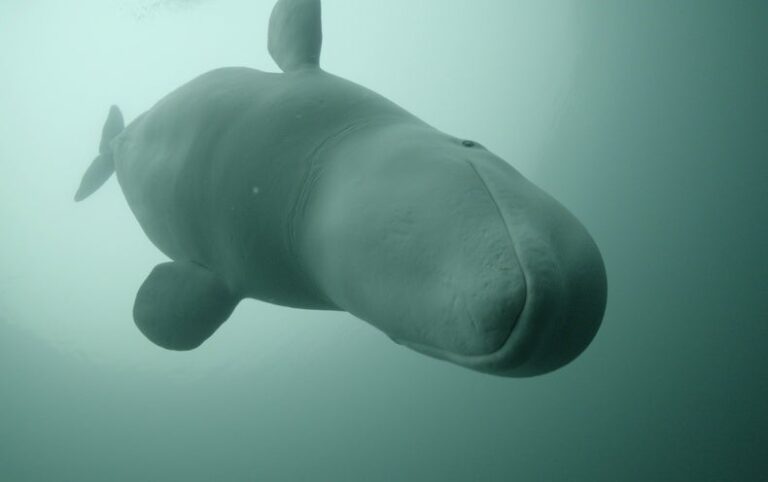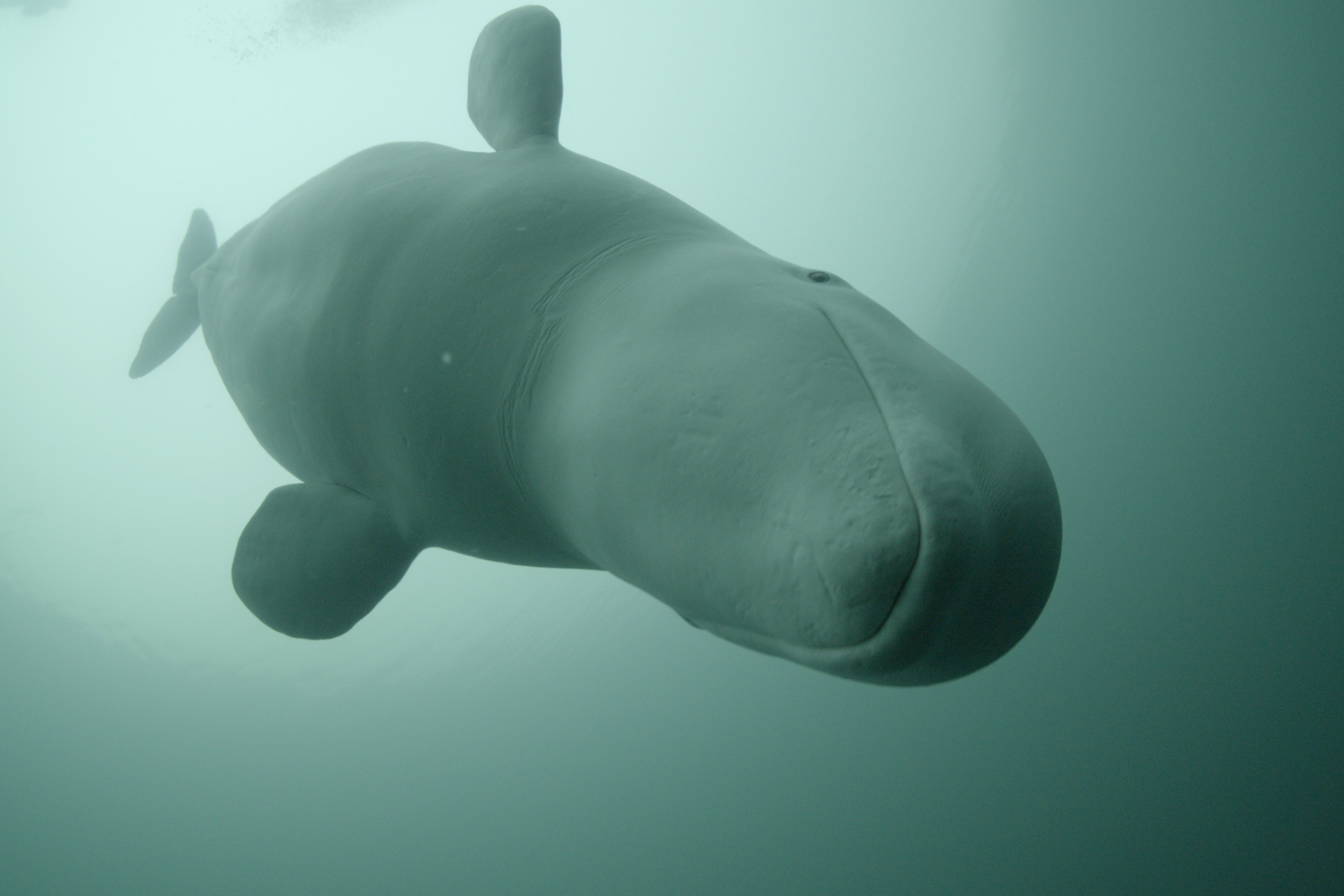
[ad_1]

Hvaldimir, a juvenile male beluga whale suspected of being part of the Russian military and known as the “spy whale,” captured the hearts of millions of people who happened upon the ball-throwing, fin-waving cetacean after he appeared in a Norwegian fjord in the spring of 2019. After four years of slowly traveling south, Hvaldimir recently sped up his movement dramatically. He has now left Norway for Swedish waters, where he is showing signs of malnourishment and dehydration. He urgently needs our help.
Sometimes an event occurs that can have profound effects and create a sea change in perception and action. I believe this is happening right now, and it began when this young beluga wearing a military harness with a camera mount and tag inscribed with the English words “Equipment St. Petersburg” appeared in a fjord in the town of Hammerfest, Norway. The mysterious white animal’s harness was quickly removed by local fishers, and he was dubbed the “spy whale.” No agency had reported the whale missing. But because of the inscription, along with past reports that the Russian navy was utilizing beluga whales in its military programs, people immediately assumed the whale had escaped, gotten lost or been released during Russian military operations.
Given his presumed Russian origin and the Norwegian word for “whale” (hval), the local Norwegians named him Hvaldimir—and people now call him Hvaldi for short.
As a cognitive psychologist and marine mammal scientist, I’ve spent much of my life observing and studying the behavior, cognitive abilities and communication of dolphins and whales. And it is clear from our observations of this whale’s behavior that Hvaldi was removed from his own social group at a young age and enculturated by norms specific to human interaction. This behavior is putting the young whale in danger. It is now our responsibility to protect him. Leading these efforts is the nonprofit OneWhale, which was formed by Regina Haug, an American filmmaker living in Norway, and is comprised of an international team of scientists, veterinarians, and other animal welfare and policy experts. I serve on the advisory board of the organization.
OneWhale has partnered with Hammerfest to build a 500-acre protected ocean reserve for Hvaldi and other whales currently living in captivity. Despite Norway’s long history of whaling—it is one of three remaining commercial whaling countries in the world—Hammerfest nearly unanimously approved the project on March 23.
Like humans, Hvaldi is a large-brained, highly social animal. Wild beluga whales live in complex societies, where they form long-lived relationships and cooperate in foraging, offspring rearing and other activities. Like us, they are socially aware. They use whistles and other sounds to communicate with one another. They also learn by observing, listening and imitating, according to anecdotal evidence and published scientific reports. In one case, a juvenile male beluga whale at the National Marine Mammal Foundation in California, who lived with a group of dolphins and had some social interactions with two female belugas, spontaneously began producing strikingly humanlike sounds. And like us, belugas learn societal norms, including the vocal communication signals and behavior patterns of their group. In other words, they become enculturated in their societies in the seas.
Unlike wild belugas, however, Hvaldi is completely comfortable with humans, and as such, he puts himself in unsafe situations. During the past four years, he has fed on fish just outside the circular nets of industrial salmon farms that dot the Norwegian coastline. In doing so, this social and curious whale has often tried to engage with the workers and has frequently disrupted their operations. The farm workers have been kind to him, but they can’t be responsible for his care and have often contacted OneWhale to remove him from the area.
Hvaldi can also be mischievous. He has been known to find ropes and tie them around boat propellors, disabling them. And on one occasion, he dismantled a farmer’s underwater pipes. Although this behavior may result from his past training, such pranks have led to death threats. Hvaldi’s attraction to boats has also proved dangerous for him: he has been seriously injured by boat propellers, fishing hooks and other sharp objects. These dangers only increased as he reached the Norwegian capital of Oslo and then his current location in Sweden, which has five million more people than Norway and even heavier boat traffic. Hvaldi is a lost, displaced, out-of-habitat whale. And except for some human interaction, he is all alone. He needs and deserves a safe place to live.
In recent weeks, however, things have changed dramatically for Hvaldi. The Swedish waters he finds himself in lack the plentiful amount of fish he is used to consuming. A lack of food and the long distance he has recently traversed have led to significant weight loss.
The situation gets worse. Sweden’s fisheries have warned there is a paucity of fish in their waters, although there is some hope that there may be an influx of mackerel in the near future. Ironically, despite living in water, beluga whales and other cetaceans don’t drink water but instead metabolize all their water from the fish they eat. Therefore, when cetaceans don’t eat for long periods of time, they risk becoming dehydrated. If there are no fish to eat, they will break down their own fat stores to generate metabolic water. If their fat stores are depleted, they begin to break down muscle, which can lead to more severe consequences.
It remains unclear why Hvaldi continues to move southward. From what is currently known, beluga whale seasonal movements and behavior are ultimately influenced by a combination of genetic, social and environmental factors. These mammals show site fidelity, meaning they return to the same locations, and migration patterns that are culturally transmitted and thought to be passed on from beluga mothers. We don’t know anything about Hvaldi’s rearing or even if he was born in the wild.
Because he is a juvenile, Hvaldimir could live another 40 years or more. Monitoring and managing his interactions with the public or salmon farms in perpetuity is not feasible. The marine reserve in Norway would provide a protected environment for Hvaldi to live with the dignity he deserves while also ensuring that he can receive care and enrichment from an experienced team of caregivers. Right now saving Hvaldi is OneWhale’s priority.
Hvaldi has shown a strong tendency to rest under and follow catamarans. Given this proclivity to follow boats, OneWhale hopes to obtain its own catamaran or other boat to monitor and protect Hvaldimir. This vessel is essential and will have multipurpose functions: it will enable the OneWhale Team to continuously monitor him, provide lodging for the crew, provide refrigerated fish storage and allow the team to feed the whale if needed, all while providing a familiar, safe base for Hvaldi.
I believe with our knowledge comes a deep responsibility. In this case, I feel the responsibility to communicate what we have learned about these magnificent marine mammals beyond scientific forums and to share this information widely through public science communication and in political arenas. Hvaldi’s story matters, because in these rare instances when we experience personal encounters with individual animals like him, they not only reveal to us their intelligence, curiosity and social awareness but also that of their wild counterparts. The clock is ticking for Hvaldi. Without swift action, his story will not end well. Regardless of the specifics of when or exactly who habituated him to human company, it is now our responsibility to protect him.
We are in the process of trying to raise money to purchase a vessel.OneWhale has more information if you would like to join our effort in protecting Hvaldimir.
This is an opinion and analysis article, and the views expressed by the author or authors are not necessarily those of Scientific American.
[ad_2]